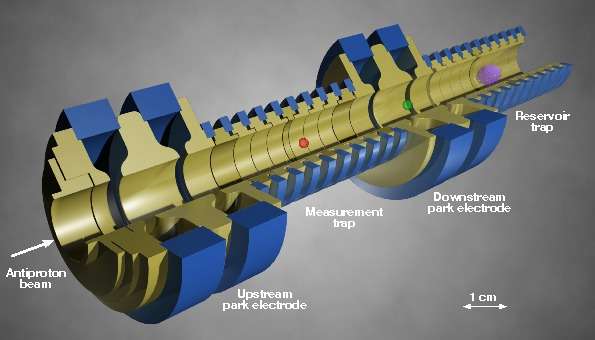Protons and antiprotons appear to be true mirror images

In a stringent test of a fundamental property of the standard model of particle physics, known as CPT symmetry, researchers from the RIKEN-led BASE collaboration at CERN have made the most precise measurements so far of the charge-to-mass ratio of protons and their antimatter counterparts, antiprotons.
The work, published in Nature, was carried out using CERN's Antiproton Decelerator, a device that provides low-energy antiprotons for antimatter studies.
CPT invariance—which the experiment was meant to test —means that a system remains unchanged if three fundamental properties are reversed—C (charge), which distinguishes matter from antimatter, P (parity), which implies a 180 degree flip in space, and T (time). It is a central tenet of the standard model, and implies that antimatter particles must be perfect mirror images of matter, with only their charges reversed.
"This is an important issue," says Stefan Ulmer, who led the research, "because it helps us to understand why we live in a universe that has practically no antimatter, despite the fact that the Big Bang must have led to the creation of both. If we had found violations of CPT, it would mean that matter and antimatter might have different properties—for example that antiprotons might decay faster than protons—but we have found within quite strict limits that the charge-to-mass ratios are the same."
To perform the research, the team used a scheme similar to that developed by the TRAP collaboration in the 1990s. They received antiprotons and negative hydrogen ions—as a proxy for protons—from the Antiproton Decelerator, and then trapped single antiproton-hydrogen ion pairs in a magnetic Penning trap, decelerating them to ultra-low energies. They then measured the cyclotron frequency of the pairs—a measurement that allows scientists to determine the charge-to-mass ratio—and compared them to find how similar they were. In total, they measured approximately 6,500 pairs over a 35-day period.
"What we found," says Ulmer, "is that the charge-to-mass ratio is identical to within just 69 parts per trillion." This measurement has four times higher energy resolution than previous measurements of proton-antiproton pairs, and further constrains the possibility of violations of CPT invariance. "Ultimately," he says, "we plan to achieve measurements that are at least ten or a hundred times more precise than the current standard."
The work also has implications for what is known as the weak equivalence principle—the idea that all particles will be affected by gravity in the same way, regardless of their mass and charge. The team used their findings to calculate that within about one part per million, antimatter and matter behave in the same way with respect to gravity.
According to BASE member Christian Smorra, "There are many reasons to believe in physics beyond the standard model, including the mystery of dark matter and, of course, the imbalance between matter and antimatter. These high-precision measurements put important new constraints and will help us to determine the direction of future research."
More information: High-precision comparison of the antiproton-to-proton charge-to-mass ratio, Nature, DOI: 10.1038/nature14861
Journal information: Nature
Provided by RIKEN




















